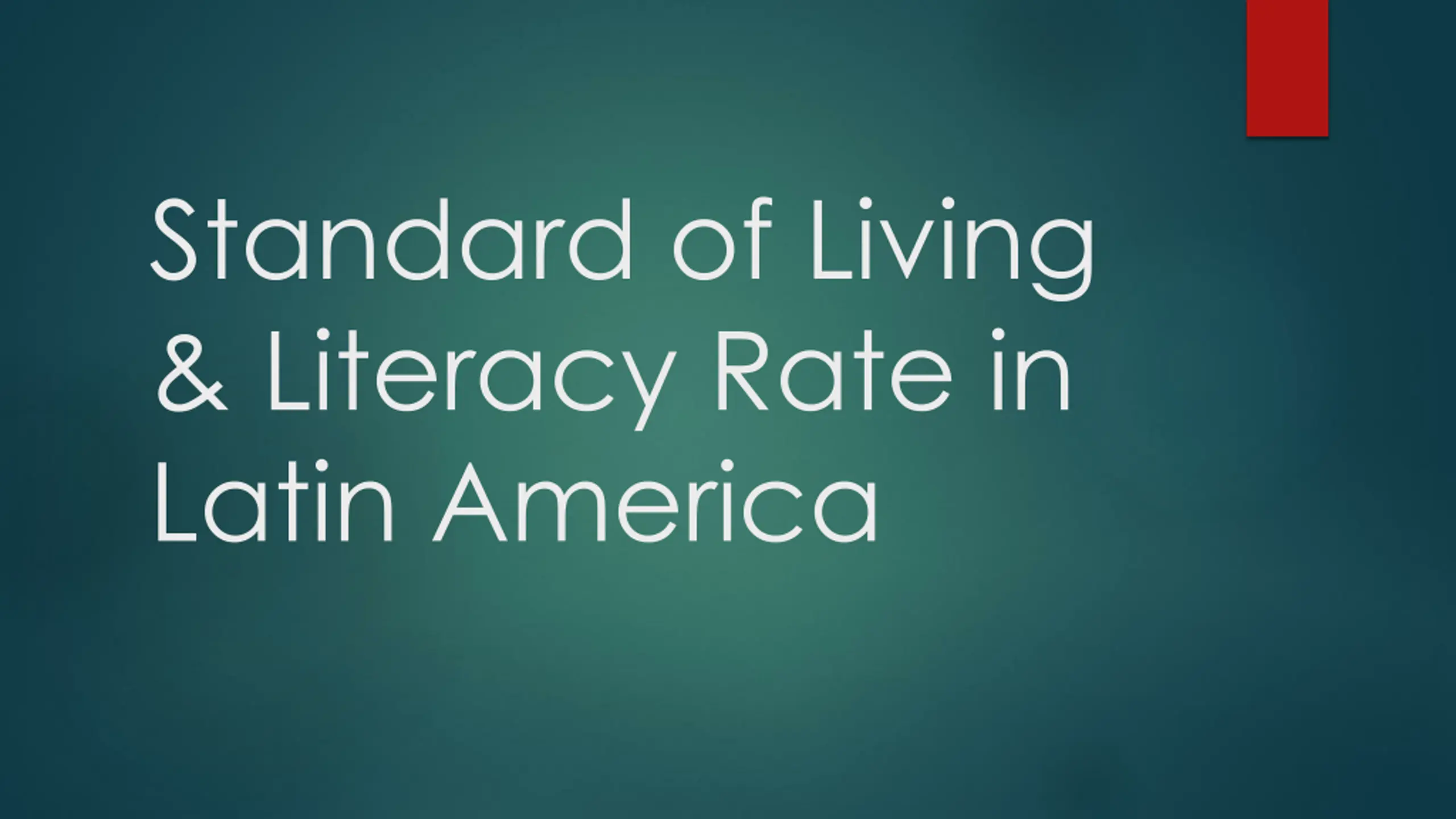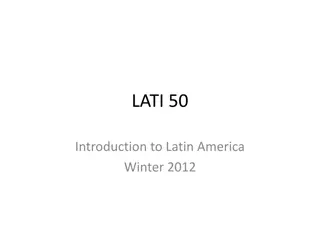Standard of Living & Literacy Rate in Latin America
High literacy rates in Latin America positively influence the standard of living. Literate individuals can access better opportunities leading to economic prosperity and break the cycle of poverty.
Download Presentation

Please find below an Image/Link to download the presentation.
The content on the website is provided AS IS for your information and personal use only. It may not be sold, licensed, or shared on other websites without obtaining consent from the author.If you encounter any issues during the download, it is possible that the publisher has removed the file from their server.
You are allowed to download the files provided on this website for personal or commercial use, subject to the condition that they are used lawfully. All files are the property of their respective owners.
The content on the website is provided AS IS for your information and personal use only. It may not be sold, licensed, or shared on other websites without obtaining consent from the author.
E N D
Presentation Transcript
Standard of Living & Literacy Rate in Latin America
What do all of these pictures have in common?
Literacy Rate A literate person is one who can read and write. Being literate is a major factor in whether a person can get a job and be successful in the workplace. Literacy rate is the percentage of a country s population over the age of 15 that can read and write. The United States has a very high literacy rate. About 99% of Americans are literate.
Economic Impact Countries with high literacy rates are generally wealthier. They can compete in the world economy. Having a high literacy rate is important to the success of the people in a country. People who can read get better jobs, earn more money, and can afford to buy better things. They can afford housing, food, healthcare, & clothing for their families.
Standard of Living The standard of living (economic level of the people in the country) is often higher in countries where the literacy rate is high. High Literacy Rate = High Standard of Living
Standard of Living This measures how well-off the people are in a country. Housing, food, health care, educational opportunities, and income can be part of the standard of living. Basically: what it costs a family to live
Cycle of Poverty Having basic reading & writing skills is very important. Without skills, workers are stuck in the lowest-paying jobs. A cycle of poverty can develop when people cannot get an education. Illiterate people are forced to get low-paying jobs, so they cannot get enough money to pay for their children s education This cycle can continue for generations. The standard of living remains low for these families because their education level is low.
Cycle of Poverty Without the skills of reading and writing, workers cannot get better jobs. Developing countries are poor, and their people are generally uneducated. It is difficult to pay for or even focus on getting an education, when there is little money for food and you are more concerned with when you are going to eat again than what is on the test
Literacy Rates in Latin America The average literacy rate in Latin American countries is 86.8%. Women tend to have lower literacy rates than men Illiteracy in the region often stems from lack of education Illiteracy causes the people to have low paying jobs or even no jobs at all. Without literacy, a country has difficulty improving & becoming a developed country. This is why many of the countries in this region would be considered third-world or developing.
Literacy Rate in Latin America The goal of every country is to have a 100% literacy rate among its people. One reason that many people cannot read/write is that their communities cannot afford to pay for teachers or schools. Another reason deals with the culture of the region. Some countries do not consider it important for girls to receive an education and so only boys are able to attend school.
Ways to Improve the Literacy Rate and Standard of Living In order to improve the literacy rate and standard of living for a country, the economy needs to grow. So then the question becomes, how do we grow the economy???
Remember that the four factors of production influence economic growth within a country. The 4 factors of production that influence economic growth within a country are: Natural Resources available Investment in Human Capital Investment in Capital Goods Entrepreneurship 1. 2. 3. 4. The presence or absence of these 4 factors determine the country s Gross Domestic Product (GDP) for the year.
Gross Domestic Product GDP is the total value of all the goods and services produced in that country in one year. It is a measure of how rich or poor a country is. This number is often used to compare one country to other countries around the world. It shows if the country s economy is getting better or worse. Raising the GDP of a country can improve the country s standard of living.
Gross Domestic Product Measuring the GDP each year can: Compare one country s economy to another Check a country s economic progress over time Show if the economy is growing or not While GDP is one measurement tool that economists use to determine a country s standard of living, more often they choose to look at the per capita GDP. Per capita GDP is the total value of all the goods and services produced in that country in one year divided by the population of the country. This number gives a more realistic look into how a country is doing compared to others.
Puerto Rico Haiti Literacy Rate 94.1 % 52. 9% Per Capita GDP $18, 700 $1, 400 Life Expectancy 78.58 years 57.56 years Unemployment Rate 12% 40.6% Based on the data presented in the chart above, in which country would you prefer to live? Why?
Things to remember Human Capital, Literacy Rate, and Standard of Living If you can read, you can learn. If you can learn, you can improve your work skills, and get a better job that pays a better salary. If you have a better salary, you can improve your standard of living. A country that improves the literacy rate among its citizens will improve the standard of living within that country and improve its economy. Educated and skilled workers are an important factor in a country s economic growth.























